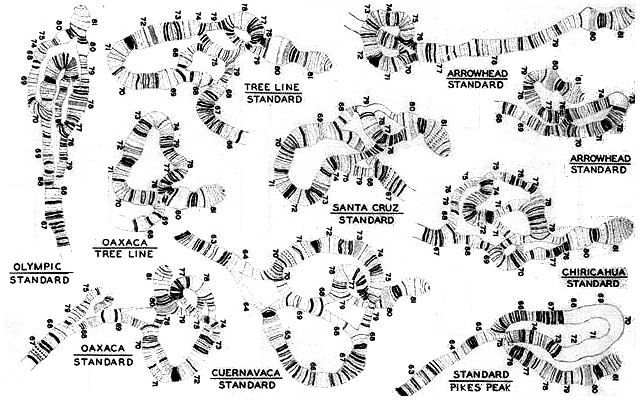
Polytene pairings of paracentric inversion polymorphisms in Drosophila pseudobscura:
Dobzhansky et al. (1937 ~ 1975) "The Genetics of Natural Populations," I - XLIII
Some of the first studies of the importance of genetics in
evolution were performed by Theodosius
Dobzhansky (1900 - 1975) on Drosophila
pseudobscura fruit flies of southwestern North America.
Where Giemsa banding patterns on the giant
salivary gland chromosomes of flies are readily
visualized, Dobzhansky showed that different geographic
populations of D. pseudobscura had undergone
paracentric inversion of specific chromosomal segments with
respect to the Standard karyotype. When genetic
crosses between these populations were made, Dobzhansky showed
that the expected inversion loops formed between the
chromosomes.
Because the heterozygous chromosome combinations were less fertile, the paracentric inversions served as reproductive barriers between populations, which allowed them to develop local genetic adaptations. For example, Dobzhansky showed that certain chromosomal types varied regularly with altitude and temperature. Such chromosome differences also exist between closely-related species in the genus Drosophila, thus showing the continuity of within- and between-species genetic variation.
Dobzhansky's 1942 book "Genetics and the Origins of Species" is considered one of the foundations of the Modern Synthesis in evolutionary biology .
Because the heterozygous chromosome combinations were less fertile, the paracentric inversions served as reproductive barriers between populations, which allowed them to develop local genetic adaptations. For example, Dobzhansky showed that certain chromosomal types varied regularly with altitude and temperature. Such chromosome differences also exist between closely-related species in the genus Drosophila, thus showing the continuity of within- and between-species genetic variation.
Dobzhansky's 1942 book "Genetics and the Origins of Species" is considered one of the foundations of the Modern Synthesis in evolutionary biology .